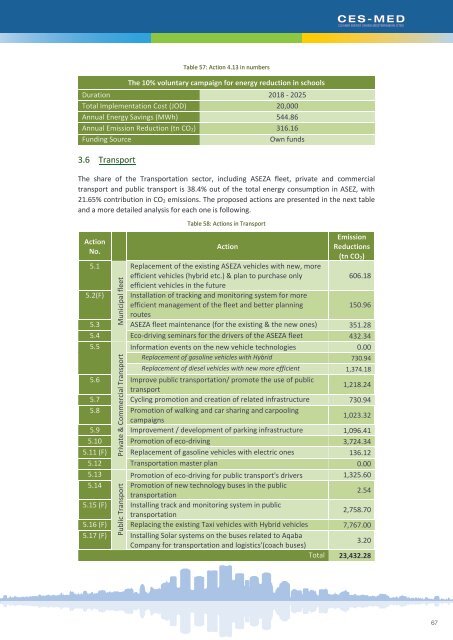161117_Jordan_ASEZA_SECAP_Revised
Create successful ePaper yourself
Turn your PDF publications into a flip-book with our unique Google optimized e-Paper software.
Table 51: Action 4.7 in numbers<br />
Replacement of existing lamps with LEDs<br />
1 st Scenario<br />
14%<br />
2 nd Scenario<br />
40%<br />
Duration 2018 – 2025 2018 - 2030<br />
Private Funds Mobilized (JOD) 16,500,00 49,494,000<br />
Annual Energy Savings (MWh) 19,743.12 59,229.35<br />
Annual Emission Reduction (tn CO 2) 11,456.26 34,368.78<br />
Funding Source<br />
Private funds<br />
Net Present Value (NPV) >>0 >>0<br />
3.5.8 Replacement of existing air conditioners with more efficient ones<br />
The hot climate in ASEZ region evokes the intense use of cooling systems in buildings and as a<br />
result, a very big percentage of electricity consumption especially in the tertiary sector is<br />
required in order to cover this need. In order to cut down the energy consumption, the<br />
replacement of the existing A/Cs with units of higher energy class until the 2030 horizon is<br />
suggested. This action leads to significant energy savings and CO 2 reduction. An overall<br />
penetration level of 25% of the action in existing tertiary sector businesses is assumed. Key<br />
data on the action are provided in the table below.<br />
Table 52: Action 4.8 in numbers<br />
Replacement of existing air conditioners with more efficient ones<br />
Duration 2018 - 2030<br />
Private Funds Mobilized (JOD) 5,624,000<br />
Annual Energy Savings (MWh) 7,342.48<br />
Annual Emission Reduction (tn CO 2) 4,260.59<br />
Funding Source<br />
Private funds<br />
Net Present Value (NPV) >>0<br />
3.5.9 Use of cool colors in rooftops<br />
The share of electricity consumption by cooling systems in tertiary buildings is very high due<br />
to the hot climate the region has. A measure to reduce this consumption is the use of cool<br />
colors in rooftops or even the external walls in order to protect the interior from the excessive<br />
heating thus maintain the inner temperature as low as it is possible.<br />
Use of cool colors and/or materials can be easily applied on the building, since its use is like<br />
any other regular paint. The energy savings from such an action are usually allocated in the<br />
top building floor and reach 20% of the electricity consumption for cooling purposes. The<br />
penetration level of this action in existing buildings is considered to be 20%, since it is an action<br />
with significant monetary savings.<br />
<strong>ASEZA</strong>’s role once again is to communicate to the citizens the benefits of this action, also<br />
utilizing the demonstrative projects and other awareness activities to be conducted.<br />
Related calculations on the action in terms of initial cost and emission savings are presented<br />
in the table below.<br />
64

















